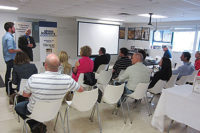Last month, I attended a session of the Marble Institute of America/Stone World education series in Boston, MA, where I also moderated a Fabricator Forum. We have been doing these educational sessions in various formats since 2005, which means we have seen them take place in a broad spectrum of climates -- from the greatness of five years ago to the depths of two years ago. In the weeks leading up to this event, I had been hearing some very positive feedback from fabricators in the New England region as well as other parts of North America, which led me to lead off the forum with some questions on the economy. By nature, stone fabricators have historically been a very candid group, and the 40 or so professionals in Boston were no exception.
They discussed their issues with a panel of speakers that included:
- Victor DeOliviera of Discover Marble & Granite
- John Kilfoyle of United Marble Fabricators
- Dick Laliberti of Ripano Stoneworks Ltd.
Are you tracking your costs in a formal way?
The vast majority of fabricators in attendance said that they maintain spreadsheets of their fabrication costs, with some tracking the production rates of costs of each step of the process -- sawing, edging, installing, etc. According to the fabricators involved in the discussion, this is a significant change from five years ago, when the high volume of business forced shops to focus solely on production as opposed to cost analysis. In addition to tracking costs in the shop, some fabricators said they have even conducted specific analyses of their use of electricity, cell phone service, water consumption and waste removal, which resulted in changes to the way they conduct their day-to-day business.
How are you addressing safety in your shop?
Most of the fabricators on hand said they have developed formal safety standards in their shop -- which include monthly safety meetings, detailed training programs for new employees, specific procedures and processes for slab handling and more. Surprisingly, less than half of the attendees said they have undergone an OSHA inspection, but virtually all of them expect to be visited by OSHA in the near future. A few of the fabricators in attendance said they underwent the voluntary "consultation" inspection, and it gave them valuable insight on the steps they needed to take before the mandatory inspection took place.
Are you offering kitchen demolition to your customers?
Has this resulted in liability issues? Virtually all of the fabricators on hand said that they will rip out the existing countertops for their customers for a fee (price quotes ranged from $250 to $400), but they said that this wasn't a profit center as much as a necessity in order to not lose any business from customers who require demo work. "It is the reality of today," said one fabricator. The fabricators also stated that there can be liability issues involved with demo work -- or practices such as adjusting out-of-level cabinets -- which is why it is critical to have homeowners sign an agreement to acknowledge the risks involved in demo work or other site adjustments.
What are shops doing to "go green" in their operations?
It's a buzzword, but how do you actually communicate environmentally friendly practices to your customers? Fabricators said that they are utilizing elements such as high-efficient lighting, propane heating and water recycling, and they are also promoting their remnants as "reclaimed materials." However, they pointed out that while some homeowners will inquire about "green" fabrication practices, the key factors are still quality, customer service and price as opposed to eco-friendly factors.
What are shops doing with their remnants? Are you able to profit by having "remnant sales" on the weekends?
Before addressing the question on remnants, several fabricators pointed out that they are open on the weekends anyhow, as market conditions are requiring shops to be as accessible to potential customers as they possibly can. Speaking on remnants, most of the fabricators in attendance said that it is difficult to turn a profit on remnants, even if they have technically been "paid for" by the customer that used the first portion of the slab. "It costs the same money to fabricate and install a remnant as a full slab," explained one forum participant. By carefully tracking their shop's remnant inventory, however, a handful of fabricators pointed out that processing remnants can offer an additional -- albeit relatively small -- revenue stream. Another suggestion was presented by one of the event sponsors, who pointed out that the term "remnant" might have a negative connotation associated with leftover or undesirable material. He said that some shops have begun using the term "partial slab" in order to maintain the material's perception of value.
Is anyone using digital nesting software?
Only a handful of the fabricators present said they are using digital nesting programs, although one of the shop owners on hand said that it has proven to be an effective sales aid in closing deals. After seeing the parts being mapped out on the slabs, the customers seem more likely to commit to buying. They also said that it enhances the perception of quality and professionalism within the shop.
Given the uptick in business, how many shops are planning major equipment investments in the near future?
A few impending investments were cited by the fabricators in attendance, including big-ticket items such as a bridge saw/waterjet combination. Some other fabricators said that they have actually made major investments over the past couple of years, and they have benefitted from these investments. Among the event sponsors selling machinery, one equipment supplier said that inquiries are increasing, but that some fabricators still lack confidence that market conditions will significantly improve in the near future. Speaking on second-hand machinery, the fabricators said there is still a fair amount of lightly-used equipment on the market, but not as much as they saw within the past couple of years.







